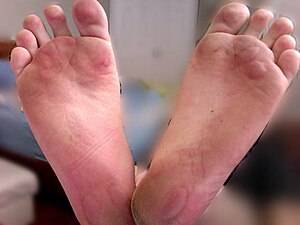 Podiatrist treating foot (Photo credit: Wikipedia)Do you suffer pain in the arch of your foot? Knee pain? Lower back pain? Have you raced off to the pharmacy to purchase the latest in arch supports from the foot department, only to come up short in the desired results department? What is real arch support and how does it help us?
Podiatrist treating foot (Photo credit: Wikipedia)Do you suffer pain in the arch of your foot? Knee pain? Lower back pain? Have you raced off to the pharmacy to purchase the latest in arch supports from the foot department, only to come up short in the desired results department? What is real arch support and how does it help us?Arch supports are inserts (off the shelf) or orthotics (prescribed by your podiatrist) that fit the arch of your foot to lend it support and prevent the stretching and small tears in the plantar fascia. The plantar fascia is the ligament that runs the length of the foot. When stressed, this area becomes painful and inflamed. The most discomfort is apparent in the morning after a night’s rest. The ligament has contracted, and the first few steps in the morning can be painful as the ligament eases.
You are most apt to experience pain if you:
• Are overweight
• Spend long periods of time running walking or standing on hard surfaces
• If your feet roll inward
• Your calf muscles and tendons are too tight
How can you regain some comfort without breaking the bank? Consider a few things you can do at home to ease the pain.
• Ice the area for 20 minutes in the morning. If you have one of these neat rolling pins that allows you to put ice water in it. Put that under the arch of your foot and roll it back and forth. If not, do an application of cold first, then do the same type of rolling exercise using a rubber ball or tennis ball.
• Rise up on toes as far as possible, hold for 5 seconds, and lower. Repeat 10 times on each foot.
• Place the ball of your foot on wall at hip height. Lean forward until you feel the stretch in your foot, but do not cause added pain. Hold stretch for 5 seconds, release and repeat 10 times on each foot.
You can try arch supports from your pharmacy, but they may not always be reliable. The combination of the exercises and arch support may be enough to give you relief, but if not, call Dr. Teichman for an appointment. Get the kind of support you really need.
References:
http://www.livestrong.com/article/335195-exercises-for-sore-feet/
http://www.footminders.com/arch-pain-treatment-foot-arch-pain-with-orthotic-insoles.html


